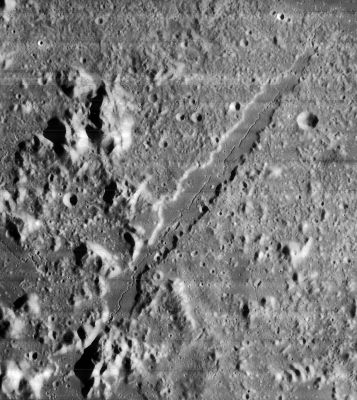Trouvelot
Contents
Trouvelot
|
Lat: 49.34°N, Long: 5.78°E, Diam: 8.91 km, Depth: 0.93 km, Rükl: 4 |

Lunar Orbiter IV image 4115-h3 submitted by Stefan Lammel. Trouvelot is at the top-right, near the end of the Alpine Valley.
Images
LPOD Photo Gallery Lunar Orbiter Images
Maps
(LAC zone 12C3) LAC map Geologic map
Description
Elger
(IAU Directions) THE GREAT ALPINE VALLEY.-- ... In the neighbourhood of the valley, on either side, there are several bright craters. Three stand near the N.W. edge, and one of considerable size near the N.E. end on the opposite side. ...
Wikipedia
Additional Information
- IAU page: Trouvelot
- Depth data from Kurt Fisher database
- Westfall, 2000: 0.93 km
- Viscardy, 1985: 1.15 km
- Trouvelot was a control point in the catalogs of both Saunder and Franz.
Nomenclature
- Etiénne Leopold Trouvelot (December 26, 1827 - April 22, 1895) was a French artist, astronomer and amateur entomologist. He is most noted for the unfortunate introduction of the Gypsy Moth into North America. Étienne lost interest in entomology and turned to astronomy. In this field he could put his skills as an artist to good use by illustrating his observations. His interest in astronomy was apparently aroused in 1870 when he witnessed several auroras. When Joseph Winlock, the director of Harvard College Observatory, saw the quality of his illustrations, he invited Étienne onto their staff in 1872. In 1875 he was invited to use the U. S. Naval Observatory to use the 26-inch refractor for a year. During the course of his life he produced about 7,000 quality astronomical illustrations. Fifteen of his most superb pastel illustrations, including one of Mare Humorum, were published by Charles Scribner's Sons in 1882. He was particularly interested in the Sun, and discovered "veiled spots" in 1875.
- Trouvelot, then known by Beer and Mädler's name of Egede D, was catalog entry 968 in Mary Blagg's Collated List.
- The name Trouvelot was suggested by Fauth and it was introduced in that form in the original IAU nomenclature of Named Lunar Formations.
- Trouvelot had been called Lévisky by Felix Chemla Lamèch, but the I.A.U. did not accept that name. Research: Ewen A. Whitaker and Danny Caes (August 2003, mail correspondence).
- Trouvelot Eta and Trouvelot Xi (two hills south of Trouvelot) (see Chart 10 in the Times Atlas of the Moon).
LPOD Articles
A Moth-Lover's View of the Moon
Bibliography
- Lamèch's "Lévisky": Mapping and Naming the Moon (Ewen A. Whitaker).
- Rosenfeld, R. and Sheehan, W. 2011. "How an artist brought the heavens to Earth." Astronomy Vol. 39, No. 1 (January issue), pp. 52-57.
- Trouvelot, Étienne Léopold. 1882. The Trouvelot astronomical drawings manual. New York: C. Scribner's Sons. (see links above for plates)
- Winlock, J. 1876. Astronomical Engravings of the Moon, Planets, Etc.. Annals of the Harvard College Observatory. (click thumbnails to see plates by Trouvelot)
E. L. Trouvelot in the Sourcebook Project (William R. Corliss)
- In Mysterious Universe, a handbook of astronomical anomalies (1979) :
Articles by E.L.Trouvelot himself:
- Page 10: Sudden Extinction of the Light of a Solar Prominence (American Journal of Science, 1878).
- Page 121: White Spots on Venus (Observatory, 1880).
- Page 161: The Moon's Zodiacal Light (American Journal of Science, 1878).
- Page 481: Phenomena observed upon Saturn (Sidereal Messenger, 1891).
Articles in which E.L.Trouvelot is mentioned:
- Page 73: The Blunted Cusp Effect and Terminator Irregularities (Dale P. Cruikshank, Strolling Astronomer, 1963).
- Page 123: On the Observed Appearance of a Remarkable Light Spot on the Night Side of Venus (Richard M. Baum, Strolling Astronomer, 1956).
- Page 162: Moon's Zodiacal Light (E.S.Holden, American Journal of Science, 1878).
Named Features -- Prev: Triplet -- Next: Trumpler